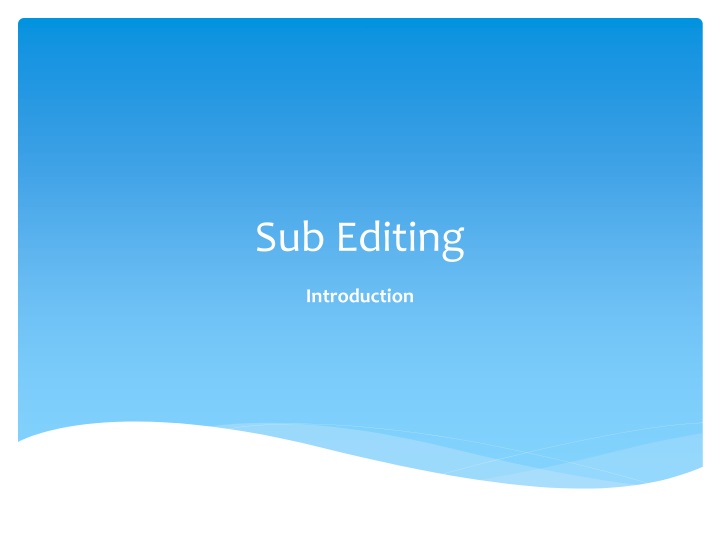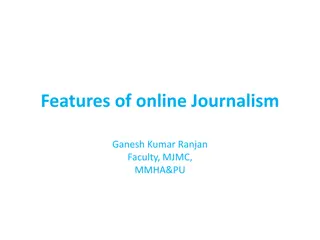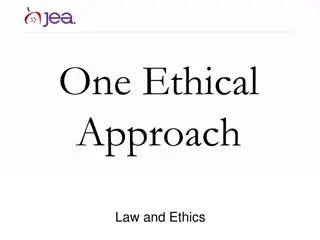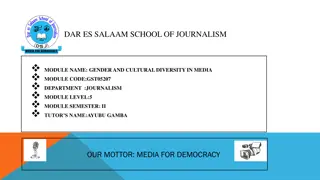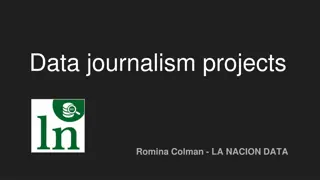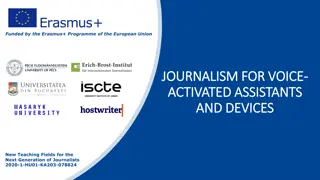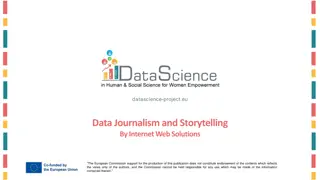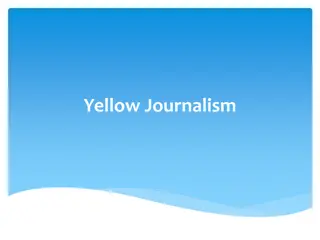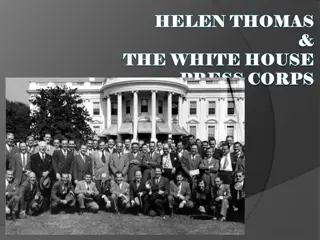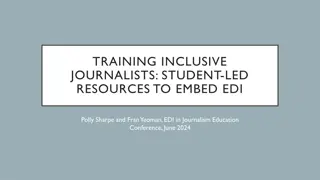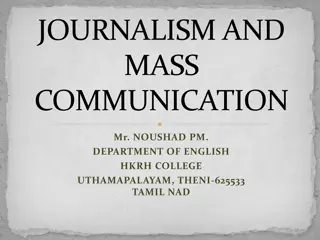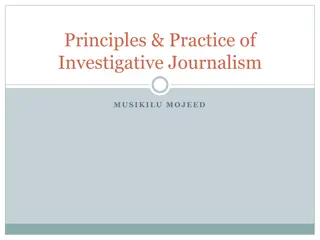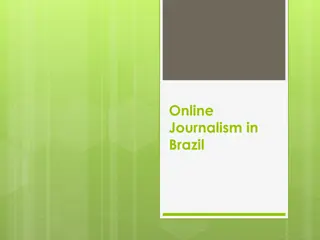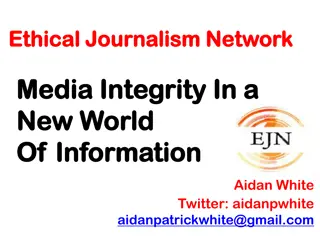The Importance of Sub-Editing in Journalism
Sub-editing plays a crucial role in journalism by enhancing news stories for clarity, accuracy, and readability. Reporters provide the content, but sub-editors refine it to align with publication policies and style. Editing involves more than just fixing grammar and factual errors; it shapes the essence of journalism. This overview explores the significance of sub-editing in presenting news stories effectively to the readers.
Download Presentation

Please find below an Image/Link to download the presentation.
The content on the website is provided AS IS for your information and personal use only. It may not be sold, licensed, or shared on other websites without obtaining consent from the author.If you encounter any issues during the download, it is possible that the publisher has removed the file from their server.
You are allowed to download the files provided on this website for personal or commercial use, subject to the condition that they are used lawfully. All files are the property of their respective owners.
The content on the website is provided AS IS for your information and personal use only. It may not be sold, licensed, or shared on other websites without obtaining consent from the author.
E N D
Presentation Transcript
Sub Editing Introduction
INTRODUCTION Reporters and correspondents write the news stories. Most of the time reporters and correspondents are in a hurry. So there is every chance of mistakes in the news stories. Reporters provide the body of the news stories. But it is the sub editor who puts 'soul' to the news stories. What sub editors do is called editing. It is also known as sub editing, subbing or copyediting. Many people think of editing as only an act of correcting the grammatical or factual mistakes in news stories. This is, however, just one aspect of editing. Editing, in fact, is the soul of journalism. It involves many things such as: Deciding what will and what will not be published, Making the selected stories palatable and presentable, and Shaping it to project the publication's policies and philosophies.
INTRODUCTION Editing is done to: Improve news stories or to change badly written news stories into readable ones. While editing: "The sub editor cares about the language, he cares about clarity of thought and of grace of expression, he cares about the traditions of journalism and the tastes of the reading public".
PRESENTATION OF CONTENT EDITING- AN OVERVIEW: What is editing? Why is editing done? Who does editing? These are some of the questions that come to the minds of beginners in the field of editing. Let us try and find answers to these basic questions. Editing is the process of improving the hurriedly written news stories and other write-ups in to readable shape. Editing in newspaper terminology is called copyediting, sub editing or subbing. The term copy editor is used in the U.S.A. while the term sub editor is used in the UK and many other countries Editing is done with specific motives of checking and improving the following: Punctuation, Spelling, Sentence Structure, Subject and Verb Agreement, Proper Word Use, Clarity, Point of View, Redundancies, Inconsistencies, Dialogue, Flow, and Format.
PRESENTATION OF CONTENT EDITING- AN OVERVIEW: In simpler terms, editing is done to improve news stories grammatically, structurally, style-wise, factually, and in terms of readability. And sub editors or copy editors do the editing. It is often thought that editors do editing but this is not so. It is the sub-editor who improves the write-ups of the reporters. And the reporters names appear with the news stories. Sub editors do not get any credit for their hard work.
PRESENTATION OF CONTENT Reporters and correspondents take to the center stage while sub editors man the backstage. Editing, or sub editing, as it is popularly known, includes many activities. These are arranging, reducing, adding, translating, selecting, checking and adapting of news and other materials for publication.
PRESENTATION OF CONTENT COPY: Copy is nothing but written pieces - news stories, articles, features, etc. coming to a newspaper's newsroom from different sources - reporters, correspondents, stringers, freelancers, news agencies, feature agencies, assigned writers, etc. With newer technologies like the internet and other digital forms of media, more copy reaches newsrooms more easily today. These need to be screened to select the necessary stories In addition to processing copy, writing headlines and moving copy to the production department, sub editors are also involved with certain aspects of production like composing, layout . Automation has made the job of sub editors easier. The ability to edit copy and writing headlines require sound judgment, scholarliness, varied exposure and experience, memory, motivation, curiosity, imagination and skepticism..
SUB EDITING- AN OVERVIEW: Sub editing or copyediting is the process by which an editor makes formatting changes and other improvements to text. A person who performs the task of copyediting is called a sub editor. The sub editor's job may be summarized in the 5 Cs: To make the copy clear, correct, concise, comprehensible, and consistent. Copy editing or sub editing typically means correcting spelling, punctuation, grammatical and semantic errors; ensuring the typescript adheres to the newspaper's own style; adding headlines, sub headlines, information graphics, blurbs and so on. These elements must be taken care of before the typesetter can prepare a final proof copy.
SUB EDITING- AN OVERVIEW: The sub editor is also expected to ensure the text flows, i.e., reads well. The job of a sub editor is to produce copy that makes sense and is fair and accurate, and that it will cause no legal problems for the publisher or editor. Newspaper sub editors are sometimes responsible for choosing which news agency copy the newspaper will use, and for rewriting it according to their house style. In many cases, a sub editor will be the only person other than the reporter to read an entire text of news stories before publication. Newspaper editors often regard their sub editors as their newspaper's last line of defense. A sub editor may abridge or shorten text, which is also called "cutting" or "trimming." This means reducing the length of a news story or article, either to fit publishing limits, or to improve the material. Omitting parts of the text, rewriting parts of the news story.
WHAT IS EDITING? The editing process begins in a newspaper with the News Editor or a Chief Sub editor sorting out the copy to eliminate reports that could not be accommodated and planning the next day s page. Only newsworthy stories get selected and are passed on to the Sub editors who check the grammar, syntax, facts and figures and logic, polish up the language and condense for economy of space. Copy is edited to highlight the news sense and to impart uniformity of style.
HOW TO EDIT A COPY Read the story once before you edit, a second time while you edit and a third time after you edit. On the first reading, if you find any ambiguity, contradiction or structural flaw, summon the reporter to demand a clarification or bring it to the notice of the News Editor or chief sub on duty. When the story has no glaring problem, it is fit to edit. A news story is divided into two parts: The Lead (the intro ), which introduces the story and The Body, which elaborates the lead. While the lead tells briefly who, what, where, when, why and how of the story, the body elaborates, details, and explains it. The lead is normally written in less than 35 words and should be crisp and concise. The inverted pyramid style of news writing technique is used which places the most significant information at the top and then places the remaining details in the descending order of importance. Each succeeding paragraph should add an essential detail without being dependent in content or style on what follows.
HOW TO EDIT A COPY The inverted pyramid style has the following advantages: i. The structure of the story remains intact even when paragraphs are deleted from the bottom for space shortage. ii. A busy reader could skip over many stories in a short time by just reading the lead paragraph. iii. It helps the sub editor to give the headline by reading the gist of the story in the Lead. iv. It is easy to change the order of paragraphs or insert a paragraph or two.
HOW TO EDIT A COPY The chronological style, which is narrating the story in the sequence in which it happened, has none of these flexibilities, and often the most important part of the story may come at the end, putting the reader s patience on trial. If the most important point in a story is buried in the last paragraph, it needs to be rewritten and brought it to the lead. In case there are more points fighting for prominence, the point that has more reader appeal is chosen. If the second paragraph does not support the lead, rewrite it. The third paragraph should further develop the second paragraph and the lead. Ideally, each paragraph should not exceed three sentences. And direct quotes add flavour to the story.
HOW TO EDIT A COPY REWRITING: Rewriting is done for the sake of clarity and highlighting the right news point, but taking care to avoid inadvertent tampering with the facts or the original meaning. Stories are also rewritten to add punch to the lead and enliven a human-interest story. HEADLINES: Headlines catch the eye of a reader in search of something interesting in a newspaper. After scanning the headlines, a reader settles down to read the story in detail. LEADS: In the journalistic parlance, the word lead is used in three or four different senses. The story with the biggest headline on the front page of a newspaper is called the lead story and in the order of priority the main stories are called Lead I, Lead II, Lead III or First Lead, Second Lead, Third Lead and so on. In the second sense, it refers to the first two or three paragraphs of a story. It is also called the Intro (short for introduction).
HOW TO EDIT A COPY Reporters often use the term in the sense of a clue to a story, upon which they work, probe, research and develop to make it a complete story. News agencies use the term in the sense of a device for updating developing stories of changing the emphasis of the story in the light of unfolding events. LANGUAGE: Words are the building blocks of writing. So, pay special attention to words, and the way they are constructed into a sentence. Misplacement of words could distort the meaning. Punctuation marks are meant for clarity and readability, and too many of them will clutter the story.
